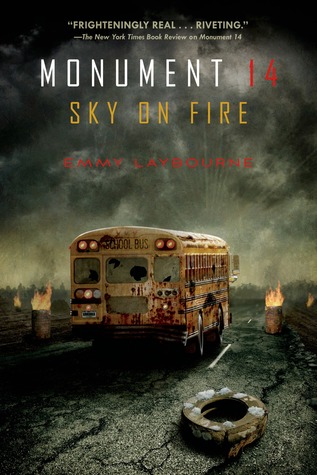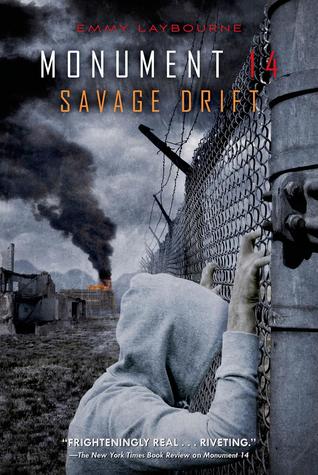Author: Emmy Laybourne
Rating: an average of 4 stars
Review Contains Spoilers

My May reading challenge for June's Fierce Reads tour event continues!
Spanning 3 novels, Laybourne's series follows a group of kids fighting to survive after a volcanic eruption sets off a chain of deadly events. The first book covers the panic as the kids are thrown together and struggle to live in a superstore. The second book shows the group splitting up, one half taking their chance in the outside world. The third portrays a semi reunion at a Canadian refugee camp before some of the main characters decide to break out to find a friend they presumed dead. Here's my new overview of all 3 books:
Spanning 3 novels, Laybourne's series follows a group of kids fighting to survive after a volcanic eruption sets off a chain of deadly events. The first book covers the panic as the kids are thrown together and struggle to live in a superstore. The second book shows the group splitting up, one half taking their chance in the outside world. The third portrays a semi reunion at a Canadian refugee camp before some of the main characters decide to break out to find a friend they presumed dead. Here's my new overview of all 3 books:
What I Liked:
- This book had every kind of apocalypse in it. The initial event, a volcano, sets off a tsunami on the entire East Coast and escalates into hail storms and chemical spills in Denver, where Monument 14 takes place. As disturbing as I sound right now, I found the escalation of disasters pretty realistic and AWESOME. As someone who lives in earthquake territory I do know earthquakes can result in tsunamis and maybe even chemical spills pending what part of the world it occurs in.
- Some of the characters kicked ass. Laybourne's writing added a brilliant innocence to her characters, some of them as young as five. Reading about the end of the world from a teenager's point of view is nothing new in YA these days. Seeing how teenagers react to children and adapt as caregivers/adults is always something I enjoy seeing through character development. All the typical characters are included: the jock/nerd/bad girl/mother figure to the kids. The tone of voice seemed spot on for kids albeit sometimes annoying. Like I said, mostly spot on from a 13-16 year-old's perspective.
- The book begins with one of the main characters, Dean, describing his seemingly normal morning before a hail storm changes his life. He doesn't have time to tell his mother he loves her before racing to catch the bus with his brother. Later on Dean torments himself about the last time he saw his mother and if his parents are even alive. The series ends with Dean and his mom hugging, hence a full circle.
- The plot was something new to me. I don't know if other YA/post apocalyptic books have explored blood types as a theme but it's new to me.The end of the world truly begins when a chemical plant spill goes airborne, affecting people differently based on their blood type. Reactions are deadly blisters, paranoia and violence. One blood type experiences no drastic side effects but results in sterility and sexual performance issues. (Not sure there's a win/win here for anyone). Readers find out the chemical plant was messing with biological warfare and science experiments. Later on camps are set up to imprison Type Os (the violent types).
What I Didn't Like:
- Baby=plot device. Sadly, I have noticed this trend in books for a long time. There's an obsession with how a new generation will survive under bleak circumstances. I'm a little tired of it. Astrid, one of the main characters and Dean's love interest, reveals she's a few months pregnant at the end of book one. Naturally the baby's father is one of the jocks and Dean's on/off again rivals. The baby becomes a central plot because Astrid and Dean are both Type O and cannot function in the outside world without masks. Living in a superstore has its benefits but holds no candle to proper healthcare or a hospital. They also can't control how the baby will react to the elements when its born. Astrid and Dean flee the refugee camp in book three because of their heightened interest in her unborn child. I also found it very unrealistic how Astrid and Dean hooked up during her pregnancy and proceeded to fall in love fast. Hormones still take over even in the hardest circumstances, I guess.
- In book three one of the Type O characters is about to undergo medical procedures for the sake of science. The lead scientist turns out to be the father of the only kid from the original group that died. He changes his mind about the medical testing and lets the group go free once he finds out they knew his son. The scientists were kind of shown as the villains of the book, at least in association with the power plant. I was okay with that but after so much haggling I found it hard to believe the bad guy would let his prey go so easily over sentimental reasons. Especially if he found out his son died while in their company regardless if it was their fault or not.
My average rating for all three books is 4 stars. Each novel had the right amount of drama, conflict and cliffhangers. I'm excited to see Emmy Laybourne in June and am thankful for the new concepts she presented in her novels!


No comments:
Post a Comment